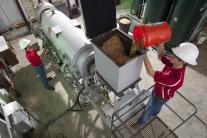The University of Louisiana at Lafayette has taken its place in the top level of the nation’s research institutions
University research benefits new biorefineries
Wed, 09/10/2014 - 3:01pmNFR BioEnergy will install biorefineries at more than 10 sugar refining hubs in south Louisiana to convert sugar cane waste, known as bagasse, into hardened energy pellets. The pellets will be used as fuel at global power plants.
Gov. Bobby Jindal and Frank Randazzo, chief operating officer of NFR BioEnergy, announced the project Monday afternoon.
The conversion of sugar cane biomass into energy pellets, through a torrefaction process, has been aided by research at the University of Louisiana at Lafayette’s Energy Institute.
“The University’s College of Engineering is excited about working with NFR BioEnergy to increase markets for Louisiana biomass,” said Dr. Mark Zappi, dean of the college.
“The UL Lafayette Energy Institute and its Cleco Alternative Energy Center offer the infrastructure and research expertise in torrefaction of sugar cane bagasse that is of great relevance to NFR BioEnergy. This project is an excellent example of how industry and academia can work together to grow Louisiana’s economy. UL Lafayette looks forward to continued collaboration with NFR BioEnergy.”
NFR BioEnergy will invest about $132 million to install the biorefineries, subject to completing lease and biomass agreements with sugar mills. It has begun development of the first one in White Castle, La., where it is co-locating the facility with the Cora Texas Sugar Mill.
The entire project is expected to create 450 new direct jobs, with an average salary of $54,000 a year, plus benefits. Louisiana Economic Development estimates it will result in an additional 1,903 new indirect jobs, for a total of more than 2,300 new jobs in the state.
Jindal said Louisiana sugar cane farmers have used innovation “to create a greater product yield through breeding techniques, higher-performing equipment and the daily application of their ingenuity. . . This project not only will create a new source of sustainable energy, but it will also create additional sources of fertilizer and lower waste and disposal costs for our sugar cane growers.
“By attracting innovative manufacturers like NFR BioEnergy, we are creating great new career opportunities and providing more jobs to Louisiana families that will further extend our state’s economic growth.”
NFR BioEnergy, now based in Plandome, N.Y., will move its headquarters to White Castle as it completes the first part of the project. A demonstration biorefinery will begin operations soon at the Cora Texas Sugar Mill. A larger, commercial-scale biorefinery also is being developed at that site, with a targeted completion in time for the 2015 sugar cane growing and refining season.
NFR BioEnergy plans to negotiate long-term supply agreements with energy customers – chiefly electricity providers in Europe, but also secondary commercial and residential markets that employ energy pellets in heating units.
Randazzo said NFR “is choosing to invest in Louisiana due to the dynamic sugar industry, hard-working people and business-friendly community. The State of Louisiana and its people have welcomed us with open arms and we look forward to contributing as active members of the community.”
Photo by Doug Dugas
Raul Viera, left, and John Pippins convert biomass into coal-like lumps packed with energy.

